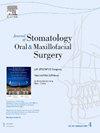Objective and automated facial palsy grading and outcome assessment after facial palsy reanimation surgery – A prospective observational study
IF 2
3区 医学
Q2 DENTISTRY, ORAL SURGERY & MEDICINE
Journal of Stomatology Oral and Maxillofacial Surgery
Pub Date : 2024-12-26
DOI:10.1016/j.jormas.2024.102211
引用次数: 0
Abstract
Background
Facial palsy (FP) is a widespread condition affecting over 3 million people annually, with a complex etiology requiring tailored, multidisciplinary management. Despite advancements, there remains a lack of reliable, automated tools for objective pre- and postoperative assessment, limiting progress in treatment optimization. This study introduces the AI Research Metrics Model (CAARISMA ® ARMM) to evaluate FP severity and outcomes following microsurgical gracilis muscle transfer.
Methods
We analyzed pre- and postoperative images of 20 FP patients using CAARISMA ® ARMM, which identifies 17 facial landmarks and evaluates 1,030 parameters. CAARISMA ® ARMM calculates three indices: Facial Youthfulness Index (FYI), Facial Aesthetic Index (FAI), and Skin Quality Index (SQI). All surgical procedures were performed by the senior author. Statistical analysis compared preoperative and postoperative scores using independent t-tests and Wilcoxon-Mann-Whitney tests, with significance set at p < 0.05.
Results
Significant improvements were observed in the FAI scores post-surgery (p < 0.001). In contrast, FYI and SQI scores did not show significant postoperative changes (p = 0.39 and p = 0.60, respectively). Significant gender differences emerged: females showed increased FYI scores postoperatively, while males exhibited a decline (p = 0.0065). Age-related variations were also significant, with younger patients showing improved SQI and older patients experiencing declines (p = 0.040).
Conclusion
The CAARISMA ® ARMM effectively captures aesthetic improvements post-reanimation. Gender and age significantly influence outcomes, underscoring the key role of personalized and adaptable assessment tools. Future studies should integrate dynamic assessments and validate the CAARISMA ® ARMM across additional patient populations. CAARISMA ® ARMM holds promise as a standardized tool in FP outcome evaluation.
客观和自动面瘫分级和面瘫再生手术后的结果评估-一项前瞻性观察研究。
背景:面瘫(FP)是一种广泛存在的疾病,每年影响超过300万人,其病因复杂,需要量身定制的多学科管理。尽管取得了进步,但仍然缺乏可靠的自动化工具来进行客观的术前和术后评估,限制了治疗优化的进展。本研究引入人工智能研究度量模型(CAARISMA®ARMM)来评估显微手术股薄肌转移后FP的严重程度和结果。方法:我们使用CAARISMA®ARMM分析了20例FP患者的术前和术后图像,该图像识别了17个面部地标并评估了1,030个参数。cararisma®ARMM计算三个指数:面部年轻指数(FYI),面部美学指数(FAI)和皮肤质量指数(SQI)。所有手术均由资深作者完成。统计学分析采用独立t检验和Wilcoxon-Mann-Whitney检验比较术前、术后评分,p < 0.05为显著性。结果:术后FAI评分显著改善(p < 0.001)。FYI和SQI评分术后无明显变化(p = 0.39,p = 0.60)。出现了显著的性别差异:女性术后FYI评分增加,而男性则下降(p = 0.0065)。年龄相关的差异也很显著,年轻患者SQI改善,而老年患者SQI下降(p = 0.040)。结论:cararisma®ARMM能有效捕捉到复苏后的美学改善。性别和年龄对结果有重大影响,强调了个性化和适应性强的评估工具的关键作用。未来的研究应整合动态评估,并在更多的患者群体中验证CAARISMA®ARMM。cararisma®ARMM有望成为FP结果评估的标准化工具。
本文章由计算机程序翻译,如有差异,请以英文原文为准。
求助全文
约1分钟内获得全文
求助全文
来源期刊

Journal of Stomatology Oral and Maxillofacial Surgery
Surgery, Dentistry, Oral Surgery and Medicine, Otorhinolaryngology and Facial Plastic Surgery
CiteScore
2.30
自引率
9.10%
发文量
0
审稿时长
23 days
 求助内容:
求助内容: 应助结果提醒方式:
应助结果提醒方式:


